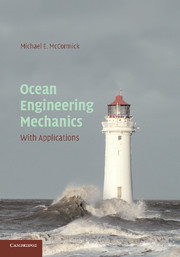Book contents
- Frontmatter
- Contents
- Preface
- Notation
- OCEAN ENGINEERING MECHANICS
- 1 Introduction
- 2 Review of Hydromechanics
- 3 Linear Surface Waves
- 4 Nonlinear Surface Waves
- 5 Random Seas
- 6 Wave Modification and Transformation
- 7 Waves in the Coastal Zone
- 8 Coastal Engineering Considerations
- 9 Wave-Induced Forces and Moments on Fixed Bodies
- 10 Introduction to Wave-Structure Interaction
- 11 Wave-Induced Motions of Floating Bodies
- 12 Wave-Induced Motions of Compliant Structures
- Appendices
- References
- Index
5 - Random Seas
Published online by Cambridge University Press: 05 June 2012
- Frontmatter
- Contents
- Preface
- Notation
- OCEAN ENGINEERING MECHANICS
- 1 Introduction
- 2 Review of Hydromechanics
- 3 Linear Surface Waves
- 4 Nonlinear Surface Waves
- 5 Random Seas
- 6 Wave Modification and Transformation
- 7 Waves in the Coastal Zone
- 8 Coastal Engineering Considerations
- 9 Wave-Induced Forces and Moments on Fixed Bodies
- 10 Introduction to Wave-Structure Interaction
- 11 Wave-Induced Motions of Floating Bodies
- 12 Wave-Induced Motions of Compliant Structures
- Appendices
- References
- Index
Summary
Let us begin by stating the term random is synonymous with unpredictable. A truly random phenomenon should by definition defy mathematical analysis. One might question then if random waves can be analyzed. By making certain assumptions, waves that are random in the time domain can be shown to have rather predictable properties in the frequency domain. In this chapter, a brief history of random wave analysis is first presented. This is followed by discussions and illustrations of the various statistical methods of wave analysis.
Introduction
We can safely assume that seafarers down through the ages have been aware of the randomness or unpredictability of ocean waves. The occurrence of “rogue waves” has been documented again and again. These are extremely high waves that occur in the open ocean without warning. The earliest attempts to deal mathematically with random waves were confined to averaging observed wave heights and periods. The data were obtained by visual means in a laboratory setting (as by Weber and Weber, 1825, according to St. Denis, 1969), in lakes, onboard a ship (as by Abercromby, 1888), or in coastal waters. When log-keeping came into being, wave height and period observations were recorded along with wind speeds. The more sophisticated mariners also recorded wavelength estimations obtained by comparing the wavelengths with lengths of their vessels. The accuracy of the wave height estimations from visual observations from ships is discussed by Cornish (1910).
- Type
- Chapter
- Information
- Ocean Engineering MechanicsWith Applications, pp. 113 - 160Publisher: Cambridge University PressPrint publication year: 2009



